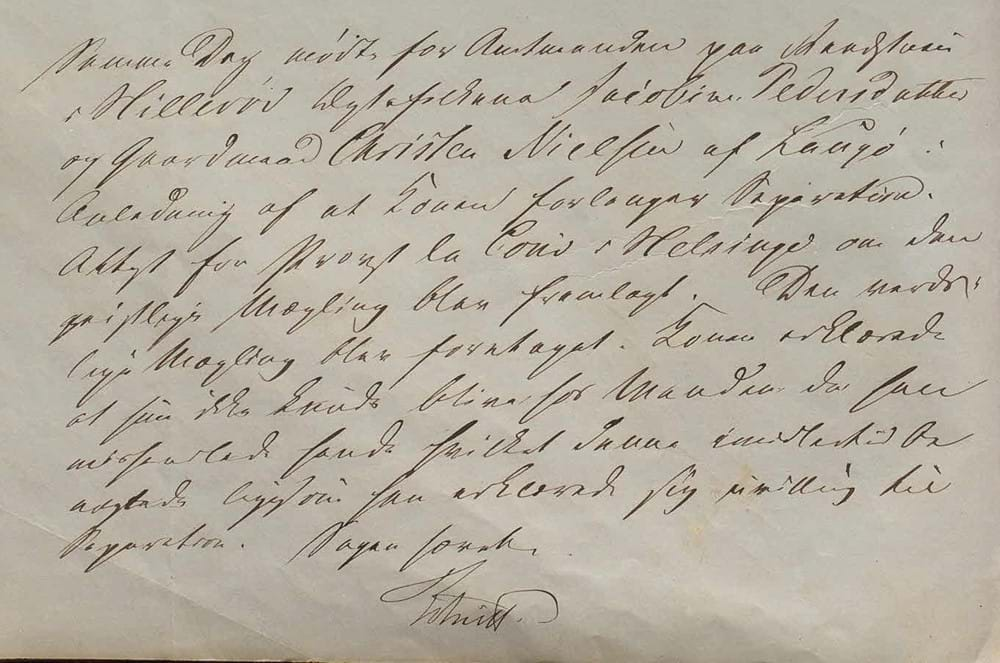Married couples who wanted to be separated or divorced, first had to go to a meeting with a mediator from the county office. Sometimes it took more than one meeting before the case was closed, as in the example shown below.

- On the same day [year 1858 on 28 January] the married couple Jacobine Pedersdatter and farmer Christen Nielsen of Langø met before the chief county administrator at the town hall in Hillerød because the wife demands separation. Certificate from minister la Cour in Helsinge about the religious mediation was produced. The secular mediation was carried out. The wife declared that she could not remain with the husband because he abused her, which he however denied, just as he declared himself unwilling to be separated. Case adjourned. [Signed] Rotwitt.1

- Year 1858 on 4 march the married couple Jacobine Pedersdatter and farmer Christen Nielsen of Langøe met before the chief county administrator at the town hall in Hillerød for secular mediation in continuation of their meeting on 28 January this year, and because the wife was still unwilling to continue the marriage, the husband declared that would now also consent to them being separated and the secular mediation was unsuccessful. The married couple thereafter agreed on being separated in terms of table and bed under the following conditions: their common estate is handed over to the probate court for division between them in equal parts after the debt is paid and from the time of the division of the estate, the joint property between them ends. Their 3 children remain with and are provided for by the father, however, the mother is granted that the children can visit her at least at times set by the authorities if disagreements should arise about that. It was said to the married couple that they must apply for permission for separation under the conditions stated above, and that a complete termination of the marriage can only take place 3 years after the date of that permission. Furthermore, the right of the authorities was explained to the husband in terms of him having to provide support to the wife, in case she would else be a burden to the pauper administration. [Signed] Christen Nielsen [and] Jacobine Pedersdatter with held pen. As guardian [signed] Jens Rasmussen. Meeting adjourned. [Signed] Rotwitt.2
Being separated "in terms of table and bed" was a standard phrase used in such cases. In Danish, the phrase is være separeret i henseende til bord og seng. Women could not make legal or financial decisions for themselves, so Jacobine had a guardian with her to the meeting. The record reveals that Christen Nielsen could write his name by himself, but Jacobine Pedersdatter could not, so someone helped her (m.f.P., means "with held pen"), most likely her guardian Jens Rasmussen.
The book has an index at the back, but beware that:
- only the husband is listed in the index,
- only the first meeting is listed in the index, and
- the digital record series called 1858-1913 contains more than one book, so you must first find the end of the correct book to find the correct index.3
The record states how many children the couple had and in which household they are likely to be found after the separation. Other clues for further research include the following:
- Religious mediation record by Minister la Cour in Helsinge. These are often not kept, but if so, they usually contain more details about the circumstances. If kept, such records are filed under the pastorate and not the parish.
- Case files from the separation and the divorce. The mediation was not a permission to be separated, but a step required for being able to apply for the permission. The couple may have been separated, but never divorced. Furthermore, if either Christen or Jacobine wanted to remarry after being divorced, he/she had to apply for permission to do so. Permissions for separation, divorce and new marriage were handled by the county office.
- Probate court record for the division of the estate. From about 1793 to 1919, probates were handled by the hundred or birch court for rural areas and by the town court for markets towns.
- What was Jacobine Pedersdatter’s relation to her guardian Jens Rasmussen? If he assisted her at the probate case, more details about him may be stated in those records.
- Alimony case. Did Jacobine apply for alimony from Christen? If so, the case was handled by the county office.
- Criminal records. Did Jacobine ever report Christen’s alleged abuse to the police? The hundred or birch bailiff handled criminal cases in rural areas, and the town bailiff handled cases in markets towns.
If you need assistance in finding information about your Danish ancestors, you are welcome to book a free planning call. I can assist you in several ways, for instance by planning research which you carry out yourself, or I can do the research for you.
Footnotes
- Frederiksborg Amt (Denmark), "Frederikborg Amt: Mæglingsprotokol for Separations- og Skilsmissesager 1858-65," page 2, secular mediation between Christen Nielsen and Jacobine Pedersdatter (28 January 1858); digital image, Rigsarkivet (https://www.sa.dk/ao-soegesider/da/billedviser?epid=16998826#123240,35954029 : accessed 27 November 2019), image 5 of 594; citing box 1: 1858-1970 Mæglingsprotokol i separations- og skilsmissesager 1858-1913, collection AB-022: Frederiksborg Amt, Landsarkivet for Sjælland.
- Ibid., pages 6-7, secular mediation between Christen Nielsen and Jacobine Pedersdatter (4 March 1858); digital image, image 7.
- Ibid., page 168, index, N, entry for Nielsen Christen and Jacobine Pedersdatter; digital image, image 88.




